2001 BMW M ROADSTER COUPE coolant level
[x] Cancel search: coolant levelPage 19 of 171
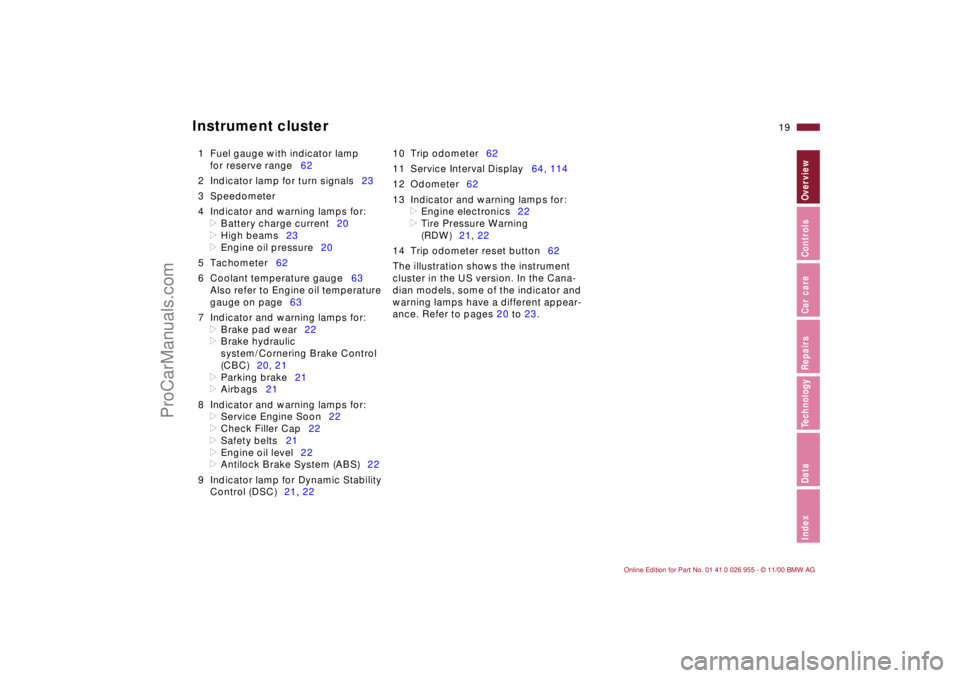
19n
IndexDataTechnologyRepairsCar careControlsOverview
Instrument cluster
1 Fuel gauge with indicator lamp
for reserve range62
2 Indicator lamp for turn signals23
3 Speedometer
4 Indicator and warning lamps for:
>
Battery charge current20
>
High beams23
>
Engine oil pressure20
5 Tachometer62
6 Coolant temperature gauge63
Also refer to Engine oil temperature
gauge on page63
7 Indicator and warning lamps for:
>
Brake pad wear22
>
Brake hydraulic
system/Cornering Brake Control
(CBC)20, 21
>
Parking brake21
>
Airbags21
8 Indicator and warning lamps for:
>
Service Engine Soon22
>
Check Filler Cap22
>
Safety belts21
>
Engine oil level22
>
Antilock Brake System (ABS)22
9 Indicator lamp for Dynamic Stability
Control (DSC)21, 2210 Trip odometer62
11 Service Interval Display64, 114
12 Odometer62
13 Indicator and warning lamps for:
>
Engine electronics22
>
Tire Pressure Warning
(RDW)21, 22
14 Trip odometer reset button62
The illustration shows the instrument
cluster in the US version. In the Cana-
dian models, some of the indicator and
warning lamps have a different appear-
ance. Refer to pages 20 to 23.
ProCarManuals.com
Page 63 of 171
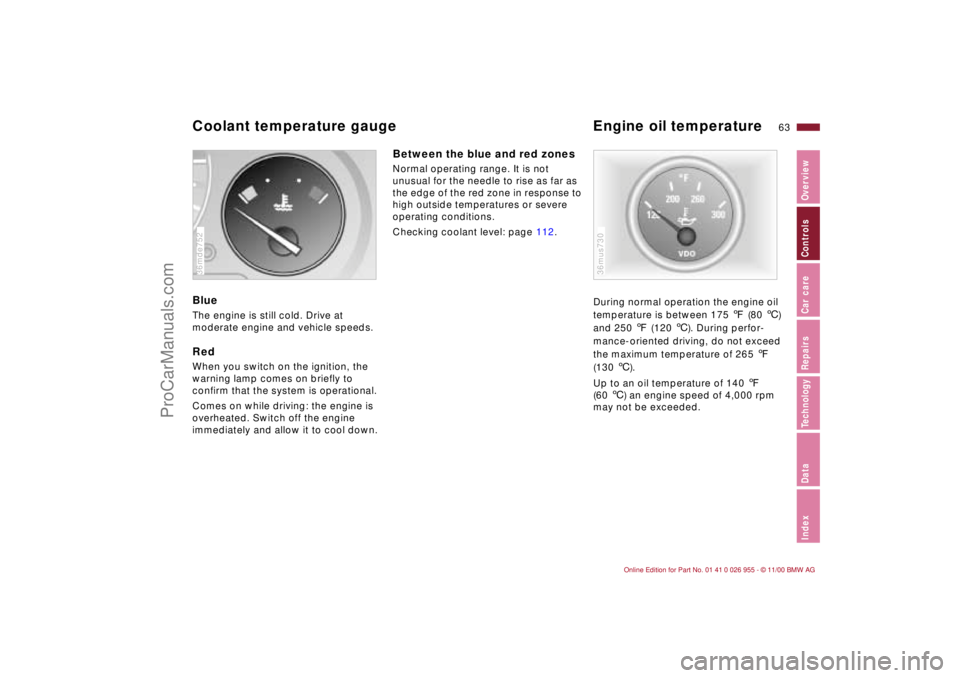
63n
IndexDataTechnologyRepairsCar careControlsOverview
Coolant temperature gauge Engine oil temperatureBlueThe engine is still cold. Drive at
moderate engine and vehicle speeds.RedWhen you switch on the ignition, the
warning lamp comes on briefly to
confirm that the system is operational.
Comes on while driving: the engine is
overheated. Switch off the engine
immediately and allow it to cool down.36mde752
Between the blue and red zonesNormal operating range. It is not
unusual for the needle to rise as far as
the edge of the red zone in response to
high outside temperatures or severe
operating conditions.
Checking coolant level: page 112.
During normal operation the engine oil
temperature is between 175 7 (80 6)
and 250 7 (120 6). During perfor-
mance-oriented driving, do not exceed
the maximum temperature of 265 7
(130 6).
Up to an oil temperature of 140 7
(60 6) an engine speed of 4,000 rpm
may not be exceeded.
36mus730
ProCarManuals.com
Page 112 of 171
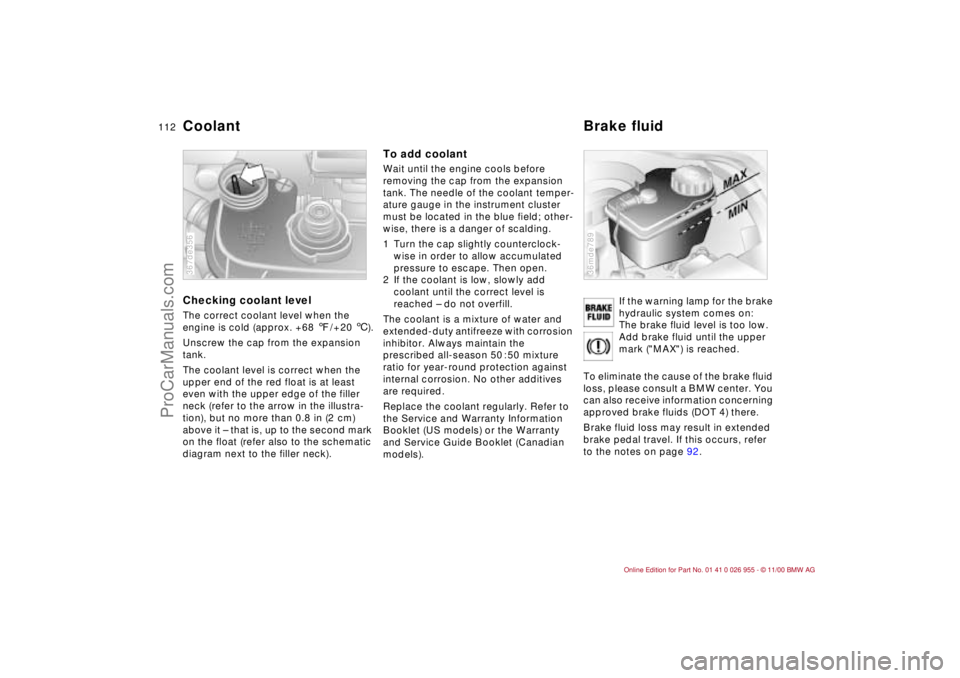
112n
Coolant Brake fluid Checking coolant levelThe correct coolant level when the
engine is cold (approx. +68 7/+20 6).
Unscrew the cap from the expansion
tank.
The coolant level is correct when the
upper end of the red float is at least
even with the upper edge of the filler
neck (refer to the arrow in the illustra-
tion), but no more than 0.8 in (2 cm)
above it – that is, up to the second mark
on the float (refer also to the schematic
diagram next to the filler neck).367de356
To add coolantWait until the engine cools before
removing the cap from the expansion
tank. The needle of the coolant temper-
ature gauge in the instrument cluster
must be located in the blue field; other-
wise, there is a danger of scalding.
1 Turn the cap slightly counterclock-
wise in order to allow accumulated
pressure to escape. Then open.
2 If the coolant is low, slowly add
coolant until the correct level is
reached – do not overfill.
The coolant is a mixture of water and
extended-duty antifreeze with corrosion
inhibitor. Always maintain the
prescribed all-season 50 : 50 mixture
ratio for year-round protection against
internal corrosion. No other additives
are required.
Replace the coolant regularly. Refer to
the Service and Warranty Information
Booklet (US models) or the Warranty
and Service Guide Booklet (Canadian
models).If the warning lamp for the brake
hydraulic system comes on:
The brake fluid level is too low.
Add brake fluid until the upper
mark ("MAX") is reached.
To eliminate the cause of the brake fluid
loss, please consult a BMW center. You
can also receive information concerning
approved brake fluids (DOT 4) there.
Brake fluid loss may result in extended
brake pedal travel. If this occurs, refer
to the notes on page 92.
36mde789
ProCarManuals.com
Page 123 of 171

123n
IndexDataTechnologyRepairsCar careControlsOverview
Storing your vehicle
If you intend to store the vehicle
for longer than three months, have
the maintenance operations described
on this page performed.<
Preparation for storageHave the following operations
performed by your BMW center:
1 Clean and apply a rustproofing agent
or other treatment to the engine,
engine compartment, undercarriage,
axles and major components in
accordance with approved repair
procedures. Wash the vehicle, clean
the interior and treat painted and
chromed parts. Clean the rubber
seals around the hood, luggage
compartment and doors.
2 Change the engine oil and oil filter
with the engine at operating tempera-
ture. As an additional corrosion
protection measure, a corrosion
inhibitor can be added to the engine
in accordance with the manufac-
turer's instructions.
3 Check the coolant level and concen-
tration and top up if necessary.
4 Check the fluid level of the wind-
shield washer fluid reservoir; top up if
necessary.
5 Fill the fuel tank completely to
prevent the formation of condensa-
tion.
6 Increase the tire inflation pressure to
51 psi (350 kPa).Before parking the vehicle for
storage1 Dry the parking brake and footbrake
by brake applications to prevent the
brake discs and drums from
corroding.
2 Park the vehicle in a covered, dry,
and well-ventilated room. Place the
transmission in 1st gear. Chock the
wheels to prevent the vehicle from
rolling if necessary. Do not apply the
parking brake.
3 Remove the battery, charge it
completely and store it in a cool (but
frost-free) room.
M roadster:
4 Remove the hardtop
* and store it
separately. Refer to page 97.
5 Close the convertible top.
During storageRecharge the battery every six months.
If it is not recharged, it will not be
serviceable. Every time the battery is
discharged, especially over extended
periods, its service life is reduced.Removing the vehicle from
storageRecharge the battery if the "Magic Eye"
turns black. Refer to page 141.
Then have Inspection I performed by
your BMW center, including a brake
fluid replacement if necessary. Refer to
the Service Manual.
ProCarManuals.com
Page 164 of 171
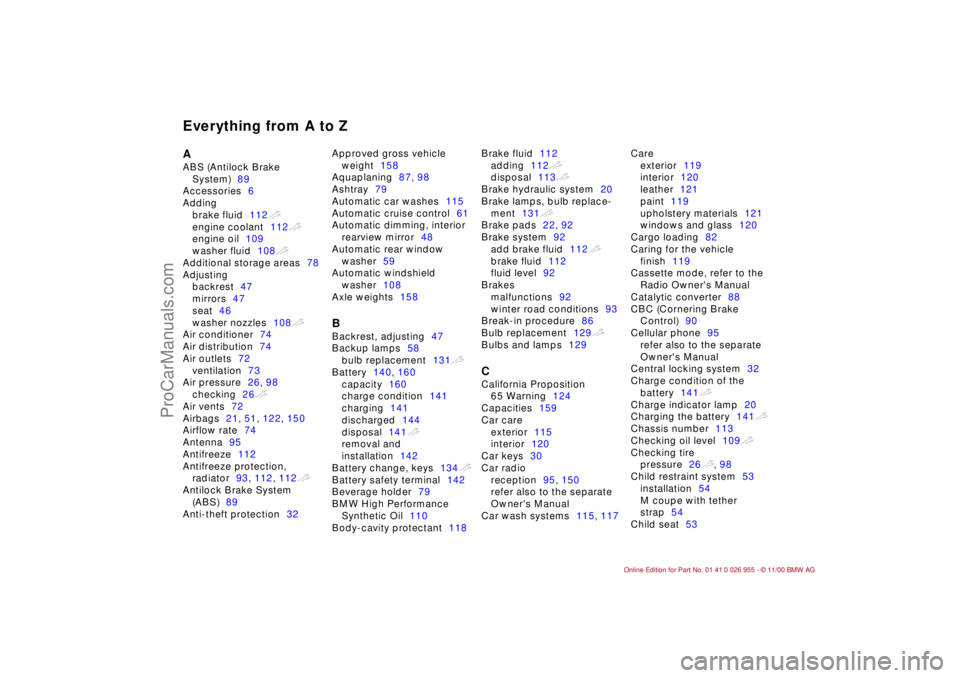
Everything from A to ZAABS (Antilock Brake
System)89
Accessories6
Adding
brake fluid112t
engine coolant112t
engine oil109
washer fluid108t
Additional storage areas78
Adjusting
backrest47
mirrors47
seat46
washer nozzles108t
Air conditioner74
Air distribution74
Air outlets72
ventilation73
Air pressure26, 98
checking26t
Air vents72
Airbags21, 51, 122, 150
Airflow rate74
Antenna95
Antifreeze112
Antifreeze protection,
radiator93, 112, 112t
Antilock Brake System
(ABS)89
Anti-theft protection32Approved gross vehicle
weight158
Aquaplaning87, 98
Ashtray79
Automatic car washes115
Automatic cruise control61
Automatic dimming, interior
rearview mirror48
Automatic rear window
washer59
Automatic windshield
washer108
Axle weights158
BBackrest, adjusting47
Backup lamps58
bulb replacement131t
Battery140, 160
capacity160
charge condition141
charging141
discharged144
disposal141t
removal and
installation142
Battery change, keys134t
Battery safety terminal142
Beverage holder79
BMW High Performance
Synthetic Oil110
Body-cavity protectant118Brake fluid112
adding112t
disposal113t
Brake hydraulic system20
Brake lamps, bulb replace-
ment131t
Brake pads22, 92
Brake system92
add brake fluid112t
brake fluid112
fluid level92
Brakes
malfunctions92
winter road conditions93
Break-in procedure86
Bulb replacement129t
Bulbs and lamps129
CCalifornia Proposition
65 Warning124
Capacities159
Car care
exterior115
interior120
Car keys30
Car radio
reception95, 150
refer also to the separate
Owner's Manual
Car wash systems115, 117Care
exterior119
interior120
leather121
paint119
upholstery materials121
windows and glass120
Cargo loading82
Caring for the vehicle
finish119
Cassette mode, refer to the
Radio Owner's Manual
Catalytic converter88
CBC (Cornering Brake
Control)90
Cellular phone95
refer also to the separate
Owner's Manual
Central locking system32
Charge condition of the
battery141t
Charge indicator lamp20
Charging the battery141t
Chassis number113
Checking oil level109t
Checking tire
pressure26t, 98
Child restraint system53
installation54
M coupe with tether
strap54
Child seat53
ProCarManuals.com
Page 165 of 171
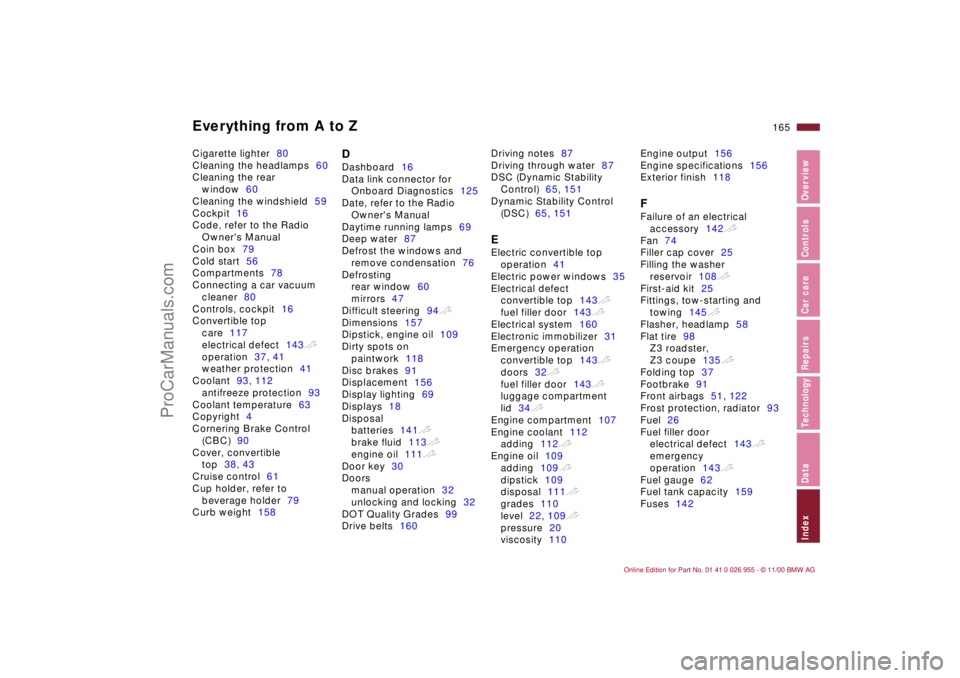
Everything from A to Z
165n
IndexDataTechnologyRepairsCar careControlsOverview
Cigarette lighter80
Cleaning the headlamps60
Cleaning the rear
window60
Cleaning the windshield59
Cockpit16
Code, refer to the Radio
Owner's Manual
Coin box79
Cold start56
Compartments78
Connecting a car vacuum
cleaner80
Controls, cockpit16
Convertible top
care117
electrical defect143t
operation37, 41
weather protection41
Coolant93, 112
antifreeze protection93
Coolant temperature63
Copyright4
Cornering Brake Control
(CBC)90
Cover, convertible
top38, 43
Cruise control61
Cup holder, refer to
beverage holder79
Curb weight158
DDashboard16
Data link connector for
Onboard Diagnostics125
Date, refer to the Radio
Owner's Manual
Daytime running lamps69
Deep water87
Defrost the windows and
remove condensation76
Defrosting
rear window60
mirrors47
Difficult steering94t
Dimensions157
Dipstick, engine oil109
Dirty spots on
paintwork118
Disc brakes91
Displacement156
Display lighting69
Displays18
Disposal
batteries141t
brake fluid113t
engine oil111t
Door key30
Doors
manual operation32
unlocking and locking32
DOT Quality Grades99
Drive belts160Driving notes87
Driving through water87
DSC (Dynamic Stability
Control)65, 151
Dynamic Stability Control
(DSC)65, 151
EElectric convertible top
operation41
Electric power windows35
Electrical defect
convertible top143t
fuel filler door143t
Electrical system160
Electronic immobilizer31
Emergency operation
convertible top143t
doors32t
fuel filler door143t
luggage compartment
lid34t
Engine compartment107
Engine coolant112
adding112t
Engine oil109
adding109t
dipstick109
disposal111t
grades110
level22, 109t
pressure20
viscosity110Engine output156
Engine specifications156
Exterior finish118
FFailure of an electrical
accessory142t
Fan74
Filler cap cover25
Filling the washer
reservoir108t
First-aid kit25
Fittings, tow-starting and
towing145t
Flasher, headlamp58
Flat tire98
Z3 roadster,
Z3 coupe135t
Folding top37
Footbrake91
Front airbags51, 122
Frost protection, radiator93
Fuel26
Fuel filler door
electrical defect143t
emergency
operation143t
Fuel gauge62
Fuel tank capacity159
Fuses142
ProCarManuals.com